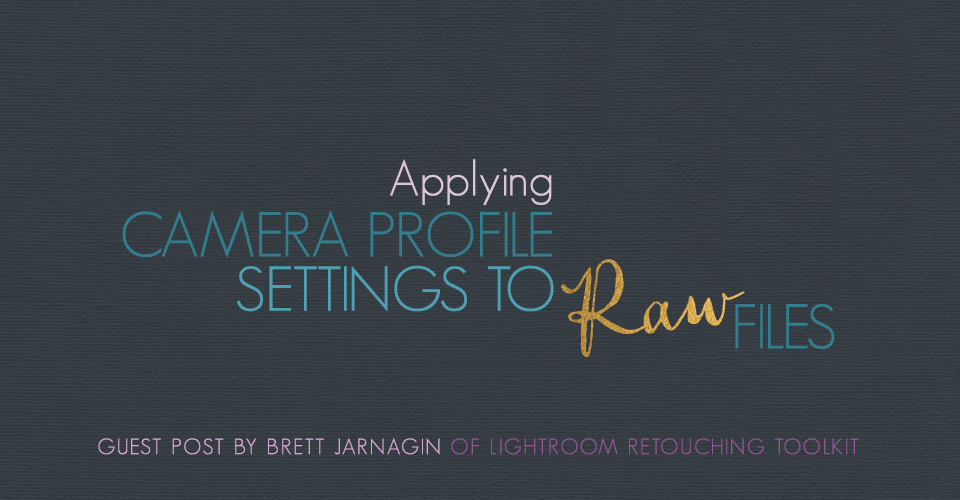Brett Jarnagin is a portrait and wedding photographer who has traveled the world teaching off-camera flash and business development to photographers. He also is the creator of the Lightroom™ Retouching Toolkit and Life. Camera. Actions., both of which help thousands of photographers in over 30 countries.
Have you ever taken a RAW image that looks great on the back of your camera and then it looks different on your computer? The colors aren’t as vibrant, the contrast is different… what the heck is going on?
What many photographers don’t realize (and get very frustrated at) is that Lightroom doesn’t automatically apply your camera profile settings. It converts them back to “Adobe Standard,” which I have found isn’t always the best option. To make adjustments to the camera profile of your RAW images, head to your Develop Module and scroll all the way to the bottom of the adjustments panel until you see “Camera Calibration” at the bottom. Click on the “Profile” dropdown menu and you will find more options. Run through them all on several different styles of images and take notes of which ones you like the best. If you don’t have options in that dropdown menu, you are most likely working with a JPEG file and not a RAW file. Below is a visualization of the Canon camera profiles. Nikon shooters will have different options.
If you are a JPEG shooter, whatever your camera profile is set to in your camera will be embedded in the image data and can’t be changed. SO, either start shooting RAW or take the time to find out what settings look best on your images and change them in your camera menu. The best route to doing this is to actually go out and shoot RAW, run through all these steps to find your favorite settings, change them in camera, and then switch back over to JPEG.
You can also make small adjustments to the hue and saturation to the reds. I like to lower the red saturation slightly just to remove some of it from the skin if it is present and also slide the hue over a little to the right to make it a little more orange than red.
These settings and options will be different for Canon and Nikon shooters. I use Canon so my examples will be of that. I encourage all to experiment and find what works for your style!
Next I will show you how to apply your favorite profile to all of your RAW images when you import them to save you even more time.
1. Find the camera profile and color settings that you like most consistently on all different types of your photographs. It is worth the time investment to make sure you are getting consistent results.
(If you find that you like multiple camera profiles, follow through until the last step with your favorite and repeat step two only with the rest. Then you can quickly change the camera profile with a preset of your own just in case the one that automatically applies doesn’t fit your style or look right.)
2. Next, click the + sign in the Preset box on the left hand side, under your image preview.
3. That will bring you to the New Develop Preset dialogue box. Name your preset at the top and select which preset folder you want it to go in. This is where you will find it in your presets menu later.
Select only the Process Version and Calibration as shown.
.
TIP: If you consistently change any one of these settings, you can make those adjustments in step two as well. Then just select them at this screen and they will also apply on import. I like to raise the Clarity to +15 and the Vibrance to +10 by default. Find what works for you!
4. Now that you have created your own preset, you can use it the next time you upload your images. When you are at the import screen, click the little dropdown arrow to see more options. Click “Develop Settings” and select the preset that you created. I would also recommend setting up your metadata and keywords because they will help with SEO. Metadata is unlikely to ever change, your keywords should fit the subject each time you import.
5. Click “Import Preset” at the bottom of the import screen and select “Save Current Settings as New Preset…”
6. You are now ready to import your photos!
7. The next time you import photos, simply click “Import Preset” at the bottom of your screen, select the one you created, and all of your settings will automatically apply on import.
Thanks for reading!
-Brett Jarnagin
Enter below for a chance to win a free copy of Lightroom™ Retouching Toolkit and use the code MILLERS20 at checkout to save $20 on your Lightroom™ Retouching Toolkit order.
*If you purchase using the discount code before the contest ends and you win, Brett will reimburse you AND give you $100!”
Tags: Guest Post, tips










I am so excited about this. I just entered to win, but may seriously need to consider the purchase if I dont! I spend so much time correcting and evening skin tones. Is this too good to be true?? Thanks for sharing!
If you use a color checker passport you can make calibration presets for all your cameras.
Thanks for the tips!
Thanks for this information, it is important for many novice photographers!
I love what you do here, I like all these works!